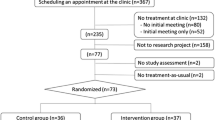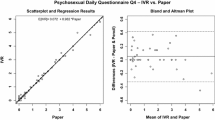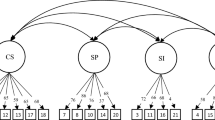Abstract
We tested the feasibility and performance of the Interactive Voice Response Technology (IVR) in the assessment of sexual behavior self-reports, relative to self-administered questionnaire (SAQ) and Timeline Followback (TLFB) methods. The sample consisted of 44 sexually active Hispanic students recruited at the University of Texas at El Paso who reported daily about sexual behaviors and substance use. Thirty-three participants (75%, 18 women, 15 men) were retained for at least 80 days of the 91-day IVR. At follow-up, sexual behaviors and substance use were assessed by questionnaire (summary) reports and by TLFB, referring to the same 3-month interval. ANOVAs with normalized variables indicated less reporting in the TLFB and over-reporting of substance use in the questionnaire relative to the daily IVR self-reports. Gender moderated the effects of assessment mode, which were observed among women only. HLM analyses indicated a significant decrease in self-reports over time, suggesting reactivity of self-monitoring via IVR on behavior.

Similar content being viewed by others
References
Armeli, S., Carney, M. A., O’Neil, T. P., Tennen, H., & Affleck, G. (2000). Stress and alcohol use: A daily process examination of the stressor-vulnerability model. Journal of Personality and Social Psychology, 78, 979–994.
Carey, M. P., Braaten, L. S., Maisto, S. A., Gleason, J. R., Forsyth, A. D., Durant, L. E. et al. (2000). Using information, motivational enhancement, and skills training to reduce the risk of HIV infection for low-income urban women: A second randomized clinical trial. Health Psychology, 19, 3–11.
Carey, M. P., Carey, K. B., Maisto, S. A., Gordon, C. M., & Weinhardt, L. S. (2001). Assessing sexual risk behavior with the Timeline Followback (TLFB) approach: Continued development and psychometric evaluation with psychiatric outpatients. International Journal of STD and AIDS, 12, 365–375.
Carey, M. P., Maisto, S. A., Kalichman, S. C., Forsyth, A. D., Wright, E. M., & Johnson, B. T. (1997). Enhancing motivation to reduce the risk of HIV infection for economically disadvantaged urban women. Journal of Consulting and Clinical Psychology, 65, 531–541.
Catania, J. A., Gibson, D. R., Chitwood, D. D., & Coates, T. J. (1990). Methodological problems in AIDS behavioral research: influences on measurement error and participation bias in studies of sexual behavior. Psychological Bulletin, 108, 339–362.
CDC (2002). HIV/AIDS among hispanics in the United States. Center for Disease Control and Prevention. Retrieved July 24, 2004, at: http://www.cdc.gov/hiv/pubs/facts/hispanic.htm.
Cohen, J. (1988). Statistical power analysis for the behavioral sciences (2nd ed.). Hillsdale, NJ: Lawrence Earlbaum Associates.
Durant, L. E., & Carey, M. P. (2000). Self-administered questionnaires versus face-to-face interviews in assessing sexual behavior in young women. Archives of Sexual Behavior, 29, 309–322.
Durant, L. E., Carey, M. P., & Schroder, K. E. E. (2002). Effects of anonymity, gender, and erotophilia on the quality of data obtained from self-reports of socially sensitive behaviors. Journal of Behavioral Medicine, 25, 439–467.
Fox, J. (1997). Applied regression analysis, linear models, and related methods. Thousand Oaks, CA: Sage.
Gillmore, M. R., Gaylord, J., Hartway, J., Hoppe, M. J., Morrison, D. M., Leigh, B. C. et al. (2001). Daily data collection of sexual and other health-related behaviors. Journal of Sex Research, 38, 35–42.
Graham, C. A., Catania, J. A., Brand, R., Duong, T., & Canchola, J. A. (2003). Recalling sexual behavior: A methodological analysis of memory recall bias via interview using the diary as a gold standard. Journal of Sex Research, 40, 325–332.
Kalichman, S. C., Rompa, D., & Coley, B. (1996). Experimental component analysis of a behavioral HIV-AIDS prevention intervention for inner-city women. Journal of Consulting & Clinical Psychology, 64, 687–693.
Keppel, G. (1991). Design and analysis: A researcher’s handbook (3rd ed.). Englewood Cliffs, NJ: Prentice Hall.
Mundt, J. C., Perrine, M. W., Searles, J. S., & Walter, D. (1995). An application of the interactive voice response technology to longitudinal studies of daily behavior. Behavior Research Methods, Instruments and Computers, 27, 351–357.
Norris, A. E., & Ford, K. (1998). Moderating influence of peer norms on gender differences in condom use. Applied Developmental Science, 2(4), 174–181.
Osborne, J. W. (2002). Notes on the use of data transformations. Practical Assessment, Research, & Evaluation, 8(6).
Perrine, M. W., Mundt, J. C., Searles, J. S., & Lester, L. S. (1995). Validation of daily self-reported alcohol consumption using interactive voice response (IVR) technology. Journal of Studies on Alcohol, 56, 487–490.
Perrine, M. W., & Schroder, K. E. E. (2005). How many drinks did you have on September 11, 2001? Journal of Studies on Alcohol, 66, 536–544.
Raudenbush, S. W., & Bryk, A. S. (2002). Hierarchical linear models. Applications and data analysis methods (2nd ed.). Thousand Oaks: Sage.
Schroder, K. E. E., Carey, M. P., & Vanable, P. A. (2003). Methodological challenges in research on sexual risk behavior: II. Accuracy of self-reports. Annals of Behavioral Medicine, 26, 104–123.
Searles, J. S., Perrine, M. W., Mundt, J. C., & Helzer, J. E. (1995). Self-report of drinking using touch-tone telephone: Extending the limits of reliable daily contact. Journal of Studies on Alcohol, 56, 375–382.
Sobell, L. C., & Sobell, M. B. (2000). Alcohol Timeline Followback (TLFB). In A. P. Association (Eds.) Handbook of psychiatric measures. Washington, DC: American Psychiatric Association.
Tabachnik, B. G., & Fidell, L. S. (2001). Computer-assisted research design and analysis. Boston, MS: Allyn & Bacon.
Weinhardt, L. S., Carey, M. P., Maisto, S. A., Carey, K. B., Cohen, M. M., & Wickramasinghe, S. M. (1998a). Reliability of the timeline follow-back sexual behavior interview. Annals of Behavioral Medicine, 20, 25–30.
Weinhardt, L. S., Forsyth, A. D., Carey, M. P., Jaworski, B. C., & Durant, L. E. (1998b). Reliability and validity of self-report measures of HIV-related sexual behavior: Progress since 1990 and recommendations for research and practice. Archives of Sexual Behavior, 27, 155–180.
Acknowledgments
This work was supported by a grant from Utah State University to Kerstin E. E. Schroder. We thank the participants and the members of the project team for their contributions to this research.
Author information
Authors and Affiliations
Corresponding author
Rights and permissions
About this article
Cite this article
Schroder, K.E.E., Johnson, C.J. & Wiebe, J.S. Interactive Voice Response Technology Applied to Sexual Behavior Self-reports: A Comparison of Three Methods. AIDS Behav 11, 313–323 (2007). https://doi.org/10.1007/s10461-006-9145-z
Published:
Issue Date:
DOI: https://doi.org/10.1007/s10461-006-9145-z




